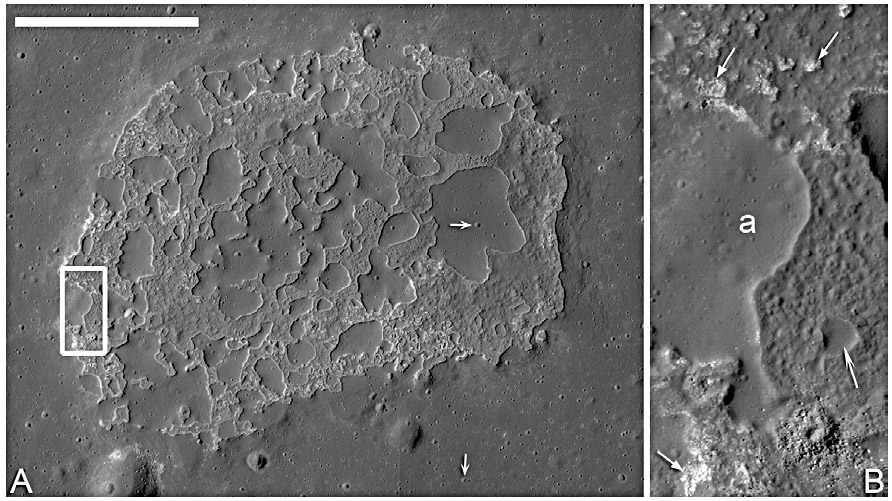Difference between revisions of "February 3, 2010"
| (8 intermediate revisions by the same user not shown) | |||
| Line 1: | Line 1: | ||
__NOTOC__ | __NOTOC__ | ||
=Ina Ain't Young= | =Ina Ain't Young= | ||
| − | + | <!-- Start of content --> | |
| − | + | <!-- ws:start:WikiTextHeadingRule:1:<h1> --> | |
| − | + | <!-- ws:start:WikiTextLocalImageRule:16:<img src="/file/view/LPOD-Feb3-10.jpg/117612631/LPOD-Feb3-10.jpg" alt="" title="" /> -->[[File:LPOD-Feb3-10.jpg|LPOD-Feb3-10.jpg]]<!-- ws:end:WikiTextLocalImageRule:16 --><br /> | |
<em>LRO images from [http://www.lpi.usra.edu/meetings/lpsc2010/pdf/2592.pdf Robinson and colleagues; LPSC 41 #2592.] White bar is 1 km in length.</em><br /> | <em>LRO images from [http://www.lpi.usra.edu/meetings/lpsc2010/pdf/2592.pdf Robinson and colleagues; LPSC 41 #2592.] White bar is 1 km in length.</em><br /> | ||
<br /> | <br /> | ||
| Line 11: | Line 11: | ||
<br /> | <br /> | ||
<strong>Related Links</strong><br /> | <strong>Related Links</strong><br /> | ||
| − | Rükl plate [ | + | Rükl plate [https://the-moon.us/wiki/R%C3%BCkl_22 22]<br /> |
<br /> | <br /> | ||
<hr /> | <hr /> | ||
| − | |||
<table class="wiki_table"> | <table class="wiki_table"> | ||
| − | + | <tr> | |
| − | + | <td> <!-- RemoveRevolverMaps --> | |
| − | + | <!-- RemoveRevolverMaps --> | |
| − | + | </td> | |
| − | ---- | + | <p><b>Yesterday's LPOD:</b> [[February 2, 2010|There is No There There]] </p> |
| − | + | <p><b>Tomorrow's LPOD:</b> [[February 4, 2010|Fold a Moon]] </p> | |
| − | + | <!-- End of content --> | |
| + | {{wiki/ArticleFooter}} | ||
Latest revision as of 17:46, 13 October 2018
Ina Ain't Young

LRO images from Robinson and colleagues; LPSC 41 #2592. White bar is 1 km in length.
Ina is a peculiar sharp-edged depression on top of a low rise. Ever since it was sighted by Apollo astronauts it has been thought to be some sort of volcanic manifestation. In 2006,Pete Schultz and colleagues proposed that it must be unusually young because its delicate details would have been toppled by normal small scale impact if it were billions of years old. This was exciting because it would be evidence that the Moon is not completely dead. Now comes a report from Mark Robinson and the LRO camera team that Ina is perhaps as old as nearby mare material. Their results are based on crater counting on images from the LRO Narrow Angle Camera images, which have ten times better resolution than previous Apollo images. There are two different units within Ina - smooth and general flat material that surprisingly is higher than than the rougher unit. The smooth unit has as many tiny impact craters as surrounding mare lavas. There are fewer craters on the rougher terrain and it is younger than the smooth material, but still much older than Schultz thought with lower resolution images. No one knows for sure what caused Ina and its two terrains. The sharp edges and roundish outlines of the smooth plateaus are clues, but their interpretation is uncertain.
Chuck Wood
Related Links
Rükl plate 22
Yesterday's LPOD: There is No There There
Tomorrow's LPOD: Fold a Moon
COMMENTS?
Register, Log in, and join in the comments.



